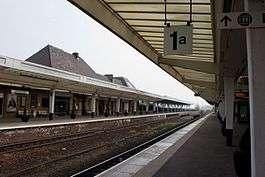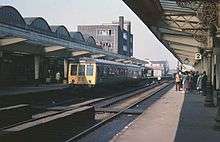Middlesbrough railway station
| Middlesbrough | |
|---|---|
 Middlesbrough railway station in 2011 | |
| Location | |
| Place | Middlesbrough |
| Local authority | Middlesbrough |
| Coordinates | 54°34′45″N 1°14′05″W / 54.579100°N 1.234720°WCoordinates: 54°34′45″N 1°14′05″W / 54.579100°N 1.234720°W |
| Grid reference | NZ495207 |
| Operations | |
| Station code | MBR |
| Managed by | TransPennine Express |
| Number of platforms | 2 |
| DfT category | C1 |
|
Live arrivals/departures, station information and onward connections from National Rail Enquiries | |
| Annual rail passenger usage* | |
| 2012/13 |
|
| 2013/14 |
|
| 2014/15 |
|
| 2015/16 |
|
| 2016/17 |
|
| History | |
| Original company | Middlesbrough and Redcar Railway |
| Pre-grouping | North Eastern Railway |
| Post-grouping | London and North Eastern Railway |
| 26 July 1847 | First station opened |
| 16 December 1874 | First station closed |
| December 1877 | First station replaced by current station[1] |
| 3 August 1942 | Station extensively damaged in air raid |
| National Rail – UK railway stations | |
| * Annual estimated passenger usage based on sales of tickets in stated financial year(s) which end or originate at Middlesbrough from Office of Rail and Road statistics. Methodology may vary year on year. | |
|
| |
Middlesbrough railway station serves the large town of Middlesbrough in North Yorkshire, England and is managed by TransPennine Express.
The main station layout consists of an entrance hall with ticket office, large concourse/waiting area and two covered platforms that are each subdivided into two sections i.e. platform 1 (1a and 1b) and platform 2 (2a and 2b). Two freight lines bypass to the north of the station.
The station is staffed and has a range of facilities including a cafe / bar, newsagent, cycle storage, toilets and lifts.[2] Various screens throughout the station give information on train arrivals and departures.
Car parking is situated just to the east of the station and can be accessed via Exchange Square and Wood Street and by footpath directly to the station. A drop-off point is located at the front of the station close to the main entrance.
According to the Office of Rail and Road statistics, Middlesbrough railway station is the fourth busiest in the North East region, with 1,356,282 total entries and exits (2016-17 period).[3]
History

The first railway was built in the area as long ago as 1830 as an extension of the Stockton and Darlington Railway to connect with the port of the then new town of Middlesbrough. A branch off this, passing just south of the new town and extending eastwards to Redcar was opened in June 1846 by the Middlesbrough and Redcar Railway Company.[4][5]
Situated on the southern edge of the new town on the Redcar branch line, Middlesbrough's first passenger station was designed by John Middleton and opened on 26 July 1847. As the town expanded rapidly during the second half of the 19th Century however, the station was unable to cope with the traffic growth. Due to the design of the station not lending itself to enlargement it was therefore demolished in 1874 and replaced by the current station, opened in December 1877.[6][7]
The current station was designed by the North Eastern Railway's chief architect, William Peachey, with an ornate Gothic style frontage. Behind this an overall roof of elliptical design once existed. Constructed out of wrought iron of lattice design, with glass covering the middle half and timber (inside)/slate (outside) covering the outer quarters. The two end screens were glazed with timber cladding around the outer edges. The roof was high in relation to its width.[8]
The elliptical roof was severely damaged in a German daylight air raid in the afternoon of 3 August 1942[9][10] and eventually removed in 1954, to be replaced by the current design over the concourse and platforms.[11]
A major refurbishment of the station took place during 2017 and 2018 with repairs carried out to the station’s roof and stonework and upgrading of the Wood Street car park.[12] New information screens were also installed as part of the refurbishment.
A new £15m station masterplan was unveiled in March 2018 with plans to open a third platform with accompanying glass frontage and concourse facing out onto Bridge Street West to accommodate the proposed re-introduction of direct trains from Middlesbrough to London in 2020.[13]
Station Masters
- John Robinson ???? - 1877[14]
- A. Pearson 1877 - 1891
- Thomas Byers ???? - 1911
- Consett Walker 1911[15] - 1927
- G.D Jackson 1927 (afterwards station master at Glasgow Queen Street)
- Edwin Weavers 1927 - 1932 (afterwards station master at Manchester Central)
- Mark Lupton 1933 - 1939[16] (formerly station master at Malton)
- R.P. Haw 1939 - 1940[17]
- J.J. Luckley 1940 - 1942
- Matthew Albert Metcalfe 1942 - 1955 (formerly station master at West Hartlepool)
- H. Thompson 1955 - 1959 (afterwards station master at York)
- T. Jackson 1960 - ????
- G.F. Weatherley ???? - 1961
- D. Finburg 1962 - 1963
- William Lake 1963 - ????
- D.W. Cooper ???? - 1965
- J.R. Brown 1965 - ???? (formerly station master at Grangetown)
Services

The station is served by a number of routes, all of which are operated by Northern, except those to Manchester that are operated by TransPennine Express.
The Tees Valley Line from Bishop Auckland & Darlington to Saltburn, (usually a British Rail Class 142 Pacer). Monday to Saturday daytimes there is a service every 30 minutes to Darlington & Saltburn and every hour to Bishop Auckland. There are also three a.m peak services to Newcastle via Durham.[18] Sundays see an hourly service to Darlington/Saltburn and a two-hourly service to Bishop Auckland.
The Esk Valley Line to Whitby via Nunthorpe and Grosmont, (usually a British Rail Class 156 Super Sprinter or Class 142 Pacer). The hourly service runs up to seventeen trains a day to Nunthorpe with four of the trains continuing to the terminus at Whitby. Sunday services (four each way, some running through to/from Newcastle) operate throughout the year.[19] A new station on the Esk Valley Line to serve the James Cook University Hospital (between Middlesbrough and Marton railway stations) was opened on 18 May 2014.[20]
The Durham Coast Line to Newcastle Central via Hartlepool and Sunderland (usually a Class 142 Pacer).[18] There is a train every hour to Newcastle (most of which continue along the Tyne Valley Line) to Hexham or Carlisle. Sundays see an hourly service through to/from the MetroCentre and Carlisle.
The North Trans-Pennine line to Manchester Airport via York and Leeds (using a British Rail Class 185 Pennine Desiro). Monday to Saturdays there is an hourly service to Manchester Airport and every two hours on Sundays. TransPennine Express also operate one daily return service to Liverpool.[21]
Under the new Northern franchise awarded to Arriva Rail North in December 2015 (commenced 1 April 2016), service frequencies on several routes are to be improved and rolling stock upgraded.[22]
On 27 November 2014, it was announced that as part of the Virgin Trains East Coast franchise, direct rail services from Middlesbrough to London would be re-introduced.[23] LNER, the current operator of the East Coast Main Line is expected to run the new Hitachi manufactured Class 800 Azuma trains to Middlesbrough in 2020.[24]
Notes
- ↑ "Railway Architecture of North East England : Middlesbrough Station". W. Fawcett, 2011. Retrieved 31 March 2014.
- ↑ "National Rail Enquiries : Middlesbrough (MBR)". National Rail. Retrieved 31 March 2014.
- ↑ "Estimates of station usage". Office of Rail and Road Website. Retrieved 2 December 2017.
- ↑ "Railway Architecture of North East England : Middlesbrough 1847 Station". W. Fawcett, 2011. Retrieved 7 December 2015.
- ↑ "December 1861 map of Middlesbrough North Riding: A Vision of Britain Through Time". University of Portsmouth and others. Retrieved 11 December 2015.
- ↑ Body 1988, pp. 118–9
- ↑ "Railway Architecture of North East England : Middlesbrough Station". W. Fawcett, 2011. Retrieved 31 March 2014.
- ↑ Delplanque, Paul. "Middlesbrough Railway Station...Then and now". GazetteLive. Retrieved 21 January 2011.
- ↑ Hitches, M - Steam Around Middlesbrough (Amberley Publishing, 2014) p. 69
- ↑ "On this day in Yorkshire 1942: Train Missed Middlesbrough Bombing by Minutes". The Yorkshire Post: Published 3 Nov 2016. Retrieved 17 July 2017.
- ↑ "Railway Architecture of North East England : Middlesbrough Station". W. Fawcett, 2011. Retrieved 26 November 2015.
- ↑ "Middlesbrough Railway Station: £2.7m refurbishment will start in the new year". GazetteLive. Retrieved 30 December 2016.
- ↑ "Middlesbrough Railway Station masterplan: New platform, 'stunning glass frontage' and better facilities". TeessideLive Website. Retrieved 26 July 2018.
- ↑ "Death of the Middlesbrough Station Master". Daily Gazette for Middlesbrough. England. 3 April 1877. Retrieved 9 September 2017 – via British Newspaper Archive. (Subscription required (help)).
- ↑ "New Stationmasters". Hartlepool Northern Daily Mail. England. 17 March 1911. Retrieved 9 September 2017 – via British Newspaper Archive. (Subscription required (help)).
- ↑ "Middlesbrough's Stationmaster Dead". Daily Gazette for Middlesbrough. England. 13 June 1939. Retrieved 9 September 2017 – via British Newspaper Archive. (Subscription required (help)).
- ↑ "Stationmaster's New Appointment". Newcastle Journal. England. 27 February 1940. Retrieved 9 September 2017 – via British Newspaper Archive. (Subscription required (help)).
- 1 2 GB National Rail Timetable May 2018, Table 44 (Network Rail)
- ↑ Table 45 National Rail timetable, May 2018
- ↑ "Middlesbrough James Cook Hospital railway station opens". BBC Tees News. Retrieved 18 May 2014.
- ↑ GB eNRT May 2018 Edition, Table 39
- ↑ Northern Franchise Improvements - DfT Retrieved 16 December 2015
- ↑ "'Mixed feelings' as plans for Teesside - London rail link announced". Middlesbrough Gazette Live. Retrieved 27 November 2014.
- ↑ "Middlesbrough station platforms 'would not fit' new London trains in 2020, warns mayor". TeessideLive Website. Retrieved 26 July 2018.
References
- Body, G (1988). PSL Field Guides - Railways of the Eastern Region Volume 2. Wellingborough: Patrick Stephens Ltd. ISBN 1-85260-072-1.
External links
| Wikimedia Commons has media related to Middlesbrough railway station. |
- Train times and station information for Middlesbrough railway station from National Rail
| Preceding station | Following station | |||
|---|---|---|---|---|
| TransPennine Express North TransPennine | Terminus | |||
| Terminus | Northern | |||
| Northern | ||||
| Northern | ||||
| Disused railways | ||||
| Terminus | Middlesbrough & Guisborough Railway | Ormesby | ||